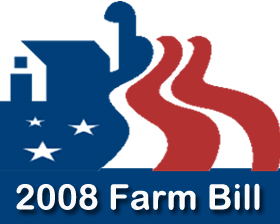Related Research Articles

The Agricultural Adjustment Act (AAA) was a United States federal law of the New Deal era designed to boost agricultural prices by reducing surpluses. The government bought livestock for slaughter and paid farmers subsidies not to plant on part of their land. The money for these subsidies was generated through an exclusive tax on companies which processed farm products. The Act created a new agency, the Agricultural Adjustment Administration, an agency of the U.S. Department of Agriculture, to oversee the distribution of the subsidies. The Agriculture Marketing Act, which established the Federal Farm Board in 1929, was seen as an important precursor to this act. The AAA, along with other New Deal programs, represented the federal government's first substantial effort to address economic welfare in the United States.

Conservation agriculture (CA) can be defined by a statement given by the Food and Agriculture Organization of the United Nations as "A farming system that promotes minimum soil disturbance, maintenance of a permanent soil cover, and diversification of plant species. It enhances Biodiversity and natural biological processes above and below the ground surface, which contribute to increased water and nutrient use efficiency and to improved and sustained crop production."
Crop insurance is purchased by agricultural producers, and subsidized by the federal government, to protect against either the loss of their crops due to natural disasters, such as hail, drought, and floods, or the loss of revenue due to declines in the prices of agricultural commodities. The two general categories of crop insurance are called crop-yield insurance and crop-revenue insurance. On average, the federal government subsidizes 62 percent of the premium. In 2019, crop insurance policies covered almost 380 million acres. Major crops are insurable in most counties where they are grown, and approximately 90% of U.S. crop acreage is insured under the federal crop insurance program. Four crops—corn, cotton, soybeans, and wheat— typically account for more than 70% of total enrolled acres. For these major crops, a large share of plantings is covered by crop insurance.

The Conservation Reserve Program (CRP) is a cost-share and rental payment program of the United States Department of Agriculture (USDA). Under the program, the government pays farmers to take certain agriculturally used croplands out of production and convert them to vegetative cover, such as cultivated or native bunchgrasses and grasslands, wildlife and pollinators food and shelter plantings, windbreak and shade trees, filter and buffer strips, grassed waterways, and riparian buffers. The purpose of the program is to reduce land erosion, improve water quality and effect wildlife benefits.

The Federal Agriculture Improvement and Reform Act of 1996, known informally as the Freedom to Farm Act, the FAIR Act, or the 1996 U.S. Farm Bill, was the omnibus 1996 farm bill that, among other provisions, revises and simplifies direct payment programs for crops and eliminates milk price supports through direct government purchases.

In the United States, the farm bill is the primary agricultural and food policy tool of the federal government. Every five years, Congress deals with the renewal and revision of the comprehensive omnibus bill.
The agricultural policy of the United States is composed primarily of the periodically renewed federal U.S. farm bills. The Farm Bills have a rich history which initially sought to provide income and price support to US farmers and prevent them from adverse global as well as local supply and demand shocks. This implied an elaborate subsidy program which supports domestic production by either direct payments or through price support measures. The former incentivizes farmers to grow certain crops which are eligible for such payments through environmentally conscientious practices of farming. The latter protects farmers from vagaries of price fluctuations by ensuring a minimum price and fulfilling their shortfalls in revenue upon a fall in price. Lately, there are other measures through which the government encourages crop insurance and pays part of the premium for such insurance against various unanticipated outcomes in agriculture.

In United States federal agriculture legislation, the Agricultural Act of 1970 initiated a significant change in commodity support policy.
The Agricultural Market Transition Act (AMTA) — Title I of the 1996 farm bill — allowed farmers who had participated in the wheat, feed grain, cotton, and rice programs in any one of the 5 years prior to 1996 to enter into 7-year production flexibility contracts for 1996-2002. Total national production flexibility contract payments for each fiscal year were fixed in the law. The AMTA allowed farmers to plant 100% of their total contract acreage to any crop except fruits and vegetables, and receive a full payment. Land had to be maintained in agricultural uses. Unlimited haying and grazing and planting and harvesting alfalfa and other forage crops was permitted with no reduction in payments. AMTA commodity support provisions were replaced by the 2002 farm bill, a 6-year farm bill.

The Agriculture and Consumer Protection Act of 1973 was the 4-year farm bill that adopted target prices and deficiency payments as a tool that would support farm income but reduce forfeitures to the Commodity Credit Corporation (CCC) of surplus stocks. It reduced payment limitations to $20,000 for all program crops. The Act might be considered the first omnibus farm bill because it went beyond simply authorizing farm commodity programs. It authorized disaster payments and disaster reserve inventories; created the Rural Environmental Conservation Program; amended the Food Stamp Act of 1964, authorized the use of commodities for feeding low income mothers and young children (the origin of the Commodity Supplemental Food Program; and amended the Rural Development Act of 1972.
In United States agricultural law, a farm’s base acreage is its crop-specific acreage of wheat, corn, grain sorghum, barley, oats, upland cotton, soybeans, canola, flax, mustard, rapeseed, safflower, sunflowers, and rice eligible to enroll in the Direct and Counter-cyclical Program (DCP) under the 2002 farm bill. A farmer’s crop acreage base is reduced by the portion of cropland placed in the Conservation Reserve Program (CRP), but increased by CRP base acreage leaving the CRP. Farmers have the choice of base acreage used to calculate Production Flexibility Contract payments for crop year 2002, or the average of acres planted for crop years 1998 through 2001.

The Food, Agriculture, Conservation, and Trade (FACT) Act of 1990 — P.L. 101-624 was a 5-year omnibus farm bill that passed Congress and was signed into law.
In the United States, deficiency payments are direct government payments made to farmers who participated in annual commodity programs for wheat, feed grains, rice, or cotton, prior to 1996.
In United States agricultural policy, the triple base plan, also called the flexible base plan, is a proposal under which farmers who raise program crops would receive program payments only on a certain percentage of their permitted acreage. A producer participating in a federal price support program actually would have three categories of base acres for program purposes:

The Food Security Act of 1985, a 5-year omnibus farm bill, allowed lower commodity price and income supports and established a dairy herd buyout program. This 1985 farm bill made changes in a variety of other USDA programs. Several enduring conservation programs were created, including sodbuster, swampbuster, and the Conservation Reserve Program.
In United States agricultural policy, the set-aside program was a program under which farmers were required to set aside a certain percentage of their total planted acreage and devote this land to approved conservation uses in order to be eligible for nonrecourse loans and deficiency payments. Set-aside acreage was based on the number of acres a farmer actually planted in the program year as opposed to being based on prior crop years. The authority for set-aside was eliminated by the 1996 farm bill.
The Direct and Counter-cyclical Payment Program (DCP) of the USDA provides payments to eligible producers on farms enrolled for the 2002 through 2007 crop years. There are two types of DCP payments – direct payments and counter-cyclical payments. Both are computed using the base acres and payment yields established for the farm. DCP was authorized by the 2002 Farm Bill and is administered by the Farm Service Agency (FSA).
Optional flex acreage is a term in United States agricultural policy.
Farm programs can be part of a concentrated effort to boost a country’s agricultural productivity in general or in specific sectors where they may have a comparative advantage. There are many different types of farm programs, with a variety of objectives and created with different economic mechanisms in mind. Some are meant to benefit farmers directly, while others seek to benefit consumers. They target food prices and quantity of food available on the market, as well as production and consumption of certain goods. Some are meant to benefit farmers directly, while others seek to benefit consumers. They target food prices and quantity of food available on the market, as well as production and consumption of certain goods.
Wheat is produced in almost every state in the United States, and is the principal cereal grain grown in the country. The type and quantity vary between regions. The US is ranked third in production volume of wheat, with almost 58 million tons produced in the 2012–2013 growing season, behind only China and India. The US is ranked first in crop export volume; almost 50% of its total wheat production is exported.
References
 This article incorporates public domain material from the Congressional Research Service document: Jasper Womach. "Report for Congress: Agriculture: A Glossary of Terms, Programs, and Laws, 2005 Edition" (PDF).
This article incorporates public domain material from the Congressional Research Service document: Jasper Womach. "Report for Congress: Agriculture: A Glossary of Terms, Programs, and Laws, 2005 Edition" (PDF).